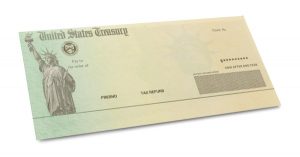
The Treasury Department and the IRS announced today that distribution of economic impact payments will begin in the next three weeks and with no action required for most people. Some senior citizens and others who do not typically file returns will need to submit a simple tax return to receive their payment.
Who is eligible?
Tax filers with adjusted gross incomes of up to $75,000 for individuals and up to $150,000 for married couples filing joint returns will receive the full payment.
For filers with income above those amounts, the payment amount is reduced by $5 for each $100 above the $75,000/$150,000 thresholds.
Who is not eligible?
Single filers with income exceeding $99,000 and $198,000 for joint filers with no children are not eligible.
Adults who can be claimed as a dependent on someone else’s return are not eligible. This group includes some high school students, many college students, and some disabled and elderly people. Immigrants who don’t have Social Security numbers also aren’t eligible, even if they have children who do.
How much will I get?
Eligible taxpayers who filed tax returns for either 2019 or 2018 will automatically receive an economic impact payment of up to $1,200 for individuals or $2,400 for married couples. Parents also receive $500 for each qualifying child under the age of 17. There are no limits on the number of children that qualify. You can find a quick calculator here.
How will I get my payment?
The vast majority of people do not need to take any action. The IRS will calculate your payment amount, and direct deposit the payment into the same banking account reflected on your 2019 return (or 2018 if you haven’t yet filed) when available.
If the IRS does not already have direct deposit information for you, you will be given an opportunity to provide it to expedite your payment. In the next few weeks, the IRS will set up a web-based portal for individuals to provide the IRS with banking information. Update 4/15/2020: The Get My Payment tool is ready. You can submit direct deposit information and check on the status of your payment here.
If you cannot or do not want to provide banking information, paper checks will be issued by mail. The Treasury Dept. estimates they can issue 5 million checks per week, and they will begin with taxpayers with the lowest incomes. Current figures show it may take up to 20 weeks for all checks to be issued.
My 2018 and 2019 returns will produce different payment amounts. Which will I get?
This could very well be the case depending on your income each year, if you had a baby or a child reach their 17th birthday, or a change in marital status. The IRS is going to look first at your 2019 return if they’ve already got it, if not they’ll use your 2018. These payments are technically advance refundable credits on your 2020 return. The final amount will be based on your 2020 income and settled on your 2020 return. If you should have gotten more (say, a baby born in 2020 you didn’t get your $500 for) you’ll get it next year at tax time. If you get sent more money than your 2020 return says you should have gotten, you won’t have to pay it back. None of this will affect any regular refund you might be entitled to next year.
Is my payment taxable?
No, the payments will not be considered 2020 taxable income.
I have an outstanding tax debt. Will I still get a payment?
Yes, these payments are exempt from rule that seizes refunds. They are not exempt from being seized for back child support.
I am not required to file a tax return. Can I still get a payment?
Yes, but you will need to file a simple tax return to receive it. This applies to some low-income taxpayers, senior citizens, Social Security recipients, some veterans and individuals with disabilities who are often not required to file an annual tax return. Update 4/1/2020: The Treasury announced that Social Security, SSDI, and Railroad Retirement beneficiaries will receive their payments automatically either as a direct deposit or by paper check, just as they would normally receive their benefits. Press Release Update 4/17/20: Supplemental Security Income and Veterans beneficiaries will now also receive their payments without taking any action. See the Non-Filers tool for details.
How do I do this?
The IRS will soon provide information instructing people in these groups on how to file a very basic 2019 tax return with the necessary information including their filing status, number of dependents and direct deposit bank account information. Update 4/10/2020: The IRS has launched a new web tool for non-filers to submit their information in order to receive an economic impact payment.
I was supposed to file for 2018 or 2019 but haven’t yet. Can I still get a payment?
If you have a filing obligation for 2018 or 2019 and have filed neither, you can still receive an economic stimulus payment. File as soon as you are able and be sure to include direct deposit information on your return.
How long do I have to claim my payment?
The economic impact payments will be available for the rest of 2020. If you need to wait until you can get an appointment with a tax professional to file a return, you will still receive your payment after filing. We will reopen our office for appointments as soon as we feel it is safe to do so. You can phone our office at 860-216-2195 for information about remote tax assistance.
IRS has limited office staff available to answer questions over the phone and many of its offices are currently shuttered. They are posting updated information at IRS.gov/coronavirus and distributing guidance to tax professionals as it becomes available. Watch for news and updates here and on our Facebook page.




